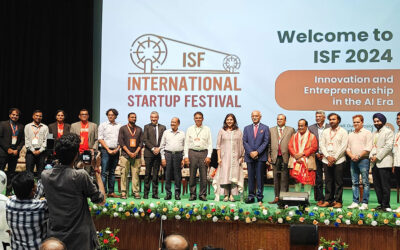2024 is poised to be a pivotal year for leading AI trends, particularly generative AI, building on its rapid rise in 2022 and initial business exploration in 2023.
In the current year, efforts are concentrated on integrating AI into everyday experiences, with a strong emphasis on trustworthiness, sustainability, and accessibility.
Consider generative AI as the next phase in the evolution of computers, transitioning from large, centralized “mainframes” to smaller, more accessible models. Open-source advancements like LLAMA and StableLM are facilitating this transition and demonstrating remarkable capabilities.
While attention often focuses on flashy AI models, the true impact lies in the background. Progress in governance, middleware, training methods, and data pipelines is silently laying the groundwork for reliable, sustainable, and user-friendly AI solutions, benefiting both businesses and individuals.
Consider generative AI as the next phase in the evolution of computers, transitioning from large, centralized “mainframes” to smaller, more accessible models. Open-source advancements like LLAMA and StableLM are facilitating this transition and demonstrating remarkable capabilities.
While attention often focuses on flashy AI models, the true impact lies in the background. Progress in governance, middleware, training methods, and data pipelines is silently laying the groundwork for reliable, sustainable, and user-friendly AI solutions, benefiting both businesses and individuals.
Artificial Intelligence in Customer Service
In 2024, AI is revolutionizing customer service practices. Chatbots have evolved to be more sophisticated and no longer robotic in their interactions. They now possess the ability to comprehend natural language, tackle complex queries, and even anticipate customer needs. This advancement enhances efficiency and personalization, enabling human agents to address more intricate issues.
Picture receiving proactive notifications about potential concerns before they impact you, or receiving tailored recommendations based on past purchases. AI have the capability to anticipate customer requirements and proactively offer solutions, preempting any potential issues.
Rather than replacing human agents, AI complements their roles by automating mundane tasks. This allows agents to concentrate on resolving complex issues and fostering stronger customer relationships. Additionally, AI equips agents with real-time insights, empowering them to deliver swifter and more knowledgeable assistance.
Apps Enhanced with Artificial Intelligence
Since 2024, there has been a significant surge in the prevalence of AI-powered applications seamlessly integrating into our daily routines.
These applications transcend mere task automation; they utilize machine learning to comprehend user behaviors and preferences.
For instance, a fitness application observes exercise routines and promptly offers personalized guidance, while a language learning app adjusts lessons based on individual performance.
These intelligent applications are revolutionizing various sectors. In healthcare, AI assistants analyze medical scans to assist physicians in diagnosis and treatment decisions. Similarly, in education, AI tutors devise customized learning plans tailored to each student’s strengths and areas needing improvement.
The potential for these advancements is immense, blurring the line between the digital and physical realms and delivering users a more intuitive and personalized experience.
Low-Code and Non-Code Software Development: Making Development Accessible
Artificial Intelligence (AI) is revolutionizing the software development landscape, particularly in the emergence of low-code and no-code platforms.
These platforms enable individuals with limited coding experience to create their own applications using intuitive drag-and-drop interfaces and pre-built components.
This democratization of development is reshaping the industry, allowing businesses to swiftly and cost-effectively develop customized solutions, fostering innovation and agility.
AI has been instrumental in powering these platforms and facilitating features such as intelligent automation, recommendation engines, and even code generation, further lowering the barrier to coding.
While not a substitute for traditional development methods, the integration of AI with low-code/no-code platforms is democratizing software development and expediting innovation in the process.
AI Jobs: Thriving or Declining
Despite concerns about AI replacing human workers, the landscape in 2024 presents a contrasting scenario. Instead of eliminating jobs, AI is generating new opportunities. There’s a growing demand for skilled professionals in AI who possess the expertise to develop, implement, and manage AI systems.
Multimodal AI: Gaining a Comprehensive Perspective
Multimodal AI represents an exciting frontier in artificial intelligence, extending beyond the processing of individual data types like text or images. This innovative technology integrates information from diverse sources such as text, speech, and visual cues, leading to a more comprehensive understanding of the world.
Imagine a virtual assistant not only comprehending spoken commands but also interpreting facial expressions and gestures. Consider using a search engine to analyze text alongside images and videos to provide richer and more relevant results. These examples offer a glimpse into the immense potential of multimodal AI.
In 2024, we anticipate significant advancements in this field. Multimodal AI is poised to revolutionize various sectors, from enhancing human-computer interaction to transforming education and healthcare.
Although challenges persist in data integration and model development, the potential for multimodal AI to overcome communication barriers and unlock new opportunities is undeniable.
Quantum Artificial Intelligence
Quantum AI represents an innovative domain merging quantum computing with artificial intelligence, offering significant potential for revolutionary breakthroughs. Despite being in its nascent stages, its possibilities are vast. Quantum computers, leveraging superposition and entanglement principles, possess the capability to address challenges beyond the reach of traditional computers. This paves the way for exciting prospects such as:
Drug discovery: Accelerating the development of life-saving medications by simulating complex interactions between molecules.
Financial Market Optimization: Quantum algorithms have the potential to analyze vast quantities of financial data and identify optimal investment strategies.
Materials science breakthroughs: Quantum simulations offer a faster approach to discovering novel materials with extraordinary properties.
Skill Enhancement for the AI Revolution
Preparing for the AI revolution requires continuous learning and skill development to remain relevant in the evolving job market. Instead of completely switching careers, focus on acquiring skills that complement AI technology. Here are some steps to get started:
- Embrace lifelong learning: Adopt a growth mindset and commit to ongoing education. Utilize online courses, workshops, and in-person training to stay updated on the latest AI advancements and their impact on your profession.
- Develop complementary skills: Concentrate on enhancing skills that humans excel at and that complement AI capabilities. These skills include critical thinking, problem-solving, creativity, communication, and emotional intelligence. They are essential for tasks such as data analysis, ethical decision-making, and collaborating effectively with AI systems.
- Become AI-literate: Gain a basic understanding of how AI functions, its limitations, and ethical considerations. This knowledge enables you to effectively utilize AI tools and discern when human intervention is necessary.
Agentic Artificial Intelligence
Step aside, Siri and Alexa, because 2024 heralds the arrival of agentic AI, a groundbreaking smart system capable of autonomously handling complex tasks with minimal human intervention. Unlike previous models, agentic AI possesses contextual understanding, adaptive capabilities, and the capacity to make intelligent decisions within its domain. Picture a personal assistant not only booking your flights but also researching your destination, offering activity suggestions, and managing travel logistics.
The advent of agentic AI opens up exciting possibilities across various industries. In healthcare, AI doctors can analyze medical records, propose diagnoses, and even devise personalized treatment plans. Agentic chatbots in customer service can adeptly address challenging queries, efficiently resolve issues, and deliver personalized real-time experiences.
However, with great power comes great responsibility. Ensuring the ethical development of agentic AI, mitigating potential biases, and establishing clear boundaries for these autonomous systems are essential steps to ensure they become safe and beneficial contributors to our lives.
In 2024, open-source AI is leading the charge in driving innovation. Open-source AI involves sharing the source code of AI tools and models with the public, fostering collaboration and rapid progress. This approach facilitates a diverse community of developers, researchers, and enthusiasts to pool their expertise, resulting in more inventive and impactful AI applications.
Well-known frameworks like TensorFlow and Py Torch serve as prime examples of open-source AI, empowering individuals and organizations to develop and deploy AI solutions across various domains. In addition to fostering innovation, open-source AI advocates for transparency and ethical development. By allowing anyone to scrutinize the code, it encourages discussions on potential biases and responsible usage.
Despite challenges such as managing extensive codebases and ensuring quality control, open-source AI offers vast potential to shape the future of AI in a collaborative and ethical manner.
Enhancements in Open Source and Smaller Language Models
In 2024, there’s a noticeable trend toward smaller, more specialized language models (SMLMs), shifting away from the dominance of large language models (LLMs) that once dominated headlines. These SMLMs are tailored for specific tasks and datasets, resulting in faster, more cost-effective, and efficient performance for everyday applications. This shift expands the utilization of AI solutions in areas such as customer service chatbots, targeted advertising, and anomaly detection in resource-constrained environments.
Concurrently, the open-source movement in AI is gaining momentum. Open-source platforms provide developers with convenient access to pre-trained models and user-friendly tools, democratizing AI and enabling individuals and organizations to leverage AI capabilities without the previously required high costs and technical expertise.
By fostering collaboration and innovation, advancements in open-source AI are democratizing access to AI beyond large corporations, making it accessible to a wider community. This trend paves the way for a more inclusive and accessible AI future, benefitting society as a whole.
Shortage of GPUs and Cloud Expenses
The advancement of AI faces two primary challenges: a shortage of powerful GPUs and the escalating costs of using cloud computing for AI. GPUs serve as the driving force behind AI innovation, and their scarcity impedes progress, particularly for smaller companies and research teams.
While cloud platforms offer access to potent resources, the associated expenses can be prohibitive, limiting AI utilization. To address these hurdles, several steps must be taken. Firstly, continuous enhancements to AI algorithms and the hardware they operate on are necessary to enhance efficiency and reduce reliance on costly equipment.
Secondly, fostering collaboration among research entities, major tech corporations, and cloud service providers is imperative. Joint efforts could yield innovative solutions that facilitate affordable access to powerful computing resources for a broader audience.
By addressing these challenges, the full potential of AI can be unlocked, ensuring its benefits are accessible to a wider array of users and applications.
Search
Categories
- AI 3
- Analytics & Data Science 16
- Blogs 7
- Brand Identity 20
- Business 9
- CMS & LMS 22
- Development 1
- Digital Marketing 19
- Digital Signage 12
- E-commerce 6
- Enterprise solution 15
- Events 1
- Internet of Things 9
- Mobile App Development 15
- News 5
- Open Source Development 12
- SEO Search engine optimization 2
- Uncategorized 2
- Web Design 1
- Web Development 19
- Web Security and Performance 18
- Website Development 1
- WordPress Development 3








